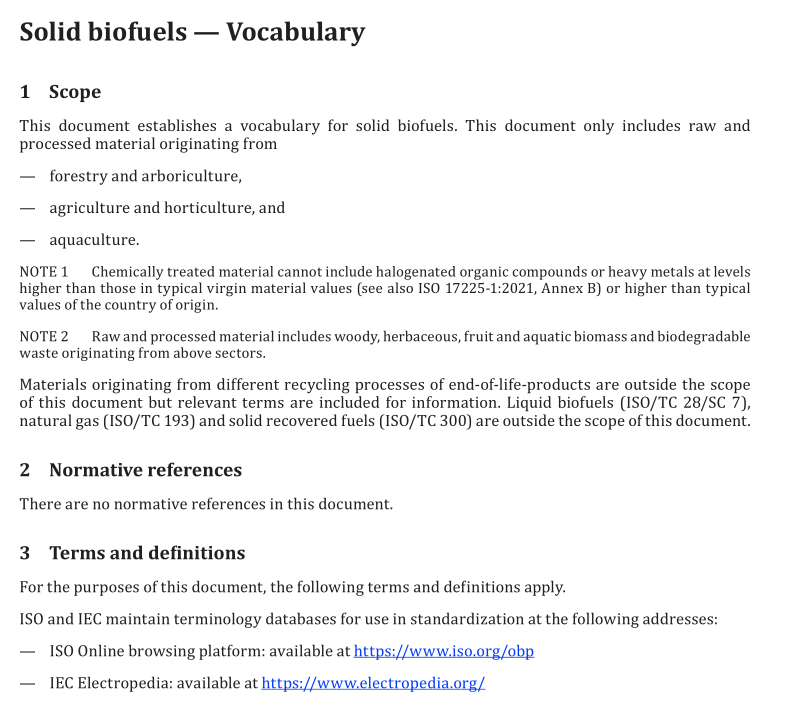ISO 16559 pdf download

ISO 16559 pdf download Solid biofuels — Vocabulary
1 Scope
This document establishes a vocabulary for solid biofuels. This document only includes raw andprocessed material originating from
– forestry and arboriculture,-agriculture and horticulture, and-aquaculture.
NOTE1 Chemically treated material cannot include halogenated organic compounds or heavy metals at levelshigher than those in typical virgin material values (see also lSso 17225-1:2021,Annex B) or higher than typicalvalues of the country of origin.
NOTE2 Raw and processed material includes woody, herbaceous, fruit and aquatic biomass and biodegradablewaste originating from above sectors.
Materials originating from different recycling processes of end-of-life-products are outside the scopeof this document but relevant terms are included for information. Liquid biofuels (ISo/TC 28/sc 7),natural gas (1So/TC193) and solid recovered fuels (ISO/TC300) are outside the scope of this document.
2Normative references
There are no normative references in this document.
3 Terms and definitions
For the purposes of this document, the following terms and definitions apply.
ISO and lEC maintain terminology databases for use in standardization at the following addresses:-ISO Online browsing platform: available at https:.//www.iso.org/obp
一IEC Electropedia: available at https://www.electropedia.org/
3.1
absorption
phenomenon whereby atoms,ions, or molecules from a gas, liquid, or dissolved solid permeates or isdissolved by a liquid or solid (the absorbent)
Note 1 to entry: Adsorption (3.3) is a surface-based process while absorption involves the whole volume(3.214)ofthe material.
3.2
additive
material which has been intentionally introduced into the fuel feedstock(3.86) to improve quality(3.160) of fuel (3.99) (e.g. combustion or durability properties), to reduce emissions or to makeproduction more efficient
Note 1 to entry: Trace amounts of, e.g. grease or other lubricants that are introduced into the fuel (3.99)processing stream as part of typical mill operations are not considered as additives.
[SOURCE: ISO 17225-2:2021,3.1]
3.3
adsorption
phenomenon whereby atoms,ions,or molecules from a gas, liquid, or dissolved solid adheres to asurface whereby the process creates a film of the adsorbate on the surface of the adsorbent
3.4
agrofuel
biofuel (3.27) obtained from energy crops (3.76) and/or agricultural by-products (agricultural residues)[SOURCE: FAO unified bioenergy terminology (UBET)]
3.5
air-dried
in a condition, in which the solid biofuel (3.185) has been brought to equilibrium moisture content( 3.132) by drying in air
3.6
angle of drain
steepest angle of descent within a silo or a hopper when granular material on the slope face is on theverge of sliding
Note 1 to entry:The angle of drain is measured in degrees of slope relative to the horizontal plane.Note 2 to entry: The angle of drain is typically a few degrees higher than the angle of repose (3.7).3.7
angle of repose
critical angle of repose
steepest angle of descent of a stock pile when granular material on the slope face is on the verge ofsliding
Note 1 to entry: The angle of repose is measured in degrees of the slope of material relative to the horizontalplane.
Note 2 to entry: The angle of repose is typically a few degrees lower than the angle of drain (3.6).3.8
animal biomass
biomass (3.32) obtained from livestock
Note 1 to entry: Animal biomass is not a solid biofuel (3.185).The term is included for information only.3.9
animal by-productsanimal residues
agricultural by-products (or agricultural residues) obtained from livestock operationsNote 1 to entry: lt includes among others solid excreta of animals.
3.10
aquatic biomass
biomass (3.32) from hydrophytic plants or hydrophytes
Note 1 to entry: Hydrophytes are plants that have adapted to living in or on aquatic environments.









